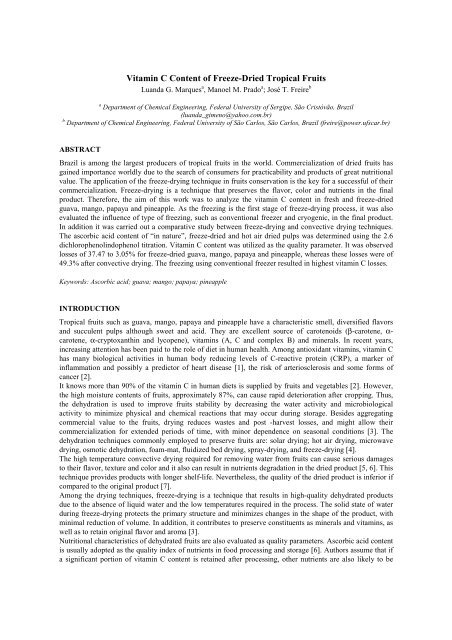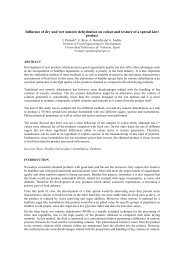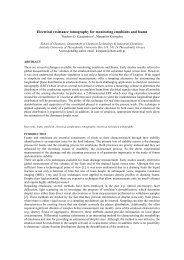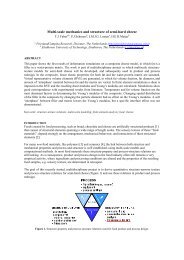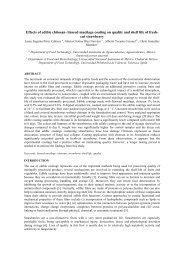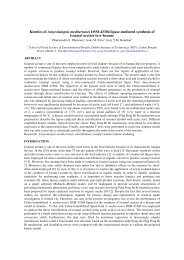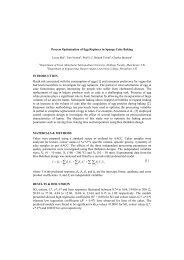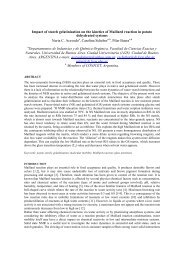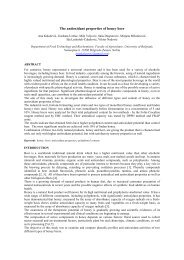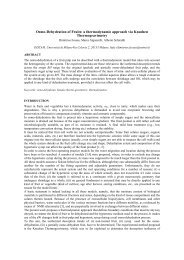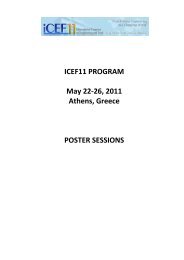Vitamin C Content of Freeze-Dried Tropical Fruits - 11th ...
Vitamin C Content of Freeze-Dried Tropical Fruits - 11th ...
Vitamin C Content of Freeze-Dried Tropical Fruits - 11th ...
You also want an ePaper? Increase the reach of your titles
YUMPU automatically turns print PDFs into web optimized ePapers that Google loves.
<strong>Vitamin</strong> C <strong>Content</strong> <strong>of</strong> <strong>Freeze</strong>-<strong>Dried</strong> <strong>Tropical</strong> <strong>Fruits</strong><br />
Luanda G. Marques a , Manoel M. Prado a ; José T. Freire b<br />
a Department <strong>of</strong> Chemical Engineering, Federal University <strong>of</strong> Sergipe, São Cristóvão, Brazil<br />
(luanda_gimeno@yahoo.com.br)<br />
b Department <strong>of</strong> Chemical Engineering, Federal University <strong>of</strong> São Carlos, São Carlos, Brazil (freire@power.ufscar.br)<br />
ABSTRACT<br />
Brazil is among the largest producers <strong>of</strong> tropical fruits in the world. Commercialization <strong>of</strong> dried fruits has<br />
gained importance worldly due to the search <strong>of</strong> consumers for practicability and products <strong>of</strong> great nutritional<br />
value. The application <strong>of</strong> the freeze-drying technique in fruits conservation is the key for a successful <strong>of</strong> their<br />
commercialization. <strong>Freeze</strong>-drying is a technique that preserves the flavor, color and nutrients in the final<br />
product. Therefore, the aim <strong>of</strong> this work was to analyze the vitamin C content in fresh and freeze-dried<br />
guava, mango, papaya and pineapple. As the freezing is the first stage <strong>of</strong> freeze-drying process, it was also<br />
evaluated the influence <strong>of</strong> type <strong>of</strong> freezing, such as conventional freezer and cryogenic, in the final product.<br />
In addition it was carried out a comparative study between freeze-drying and convective drying techniques.<br />
The ascorbic acid content <strong>of</strong> “in nature”, freeze-dried and hot air dried pulps was determined using the 2.6<br />
dichlorophenolindophenol titration. <strong>Vitamin</strong> C content was utilized as the quality parameter. It was observed<br />
losses <strong>of</strong> 37.47 to 3.05% for freeze-dried guava, mango, papaya and pineapple, whereas these losses were <strong>of</strong><br />
49.3% after convective drying. The freezing using conventional freezer resulted in highest vitamin C losses.<br />
Keywords: Ascorbic acid; guava; mango; papaya; pineapple<br />
INTRODUCTION<br />
<strong>Tropical</strong> fruits such as guava, mango, papaya and pineapple have a characteristic smell, diversified flavors<br />
and succulent pulps although sweet and acid. They are excellent source <strong>of</strong> carotenoids (β-carotene, αcarotene,<br />
α-cryptoxanthin and lycopene), vitamins (A, C and complex B) and minerals. In recent years,<br />
increasing attention has been paid to the role <strong>of</strong> diet in human health. Among antioxidant vitamins, vitamin C<br />
has many biological activities in human body reducing levels <strong>of</strong> C-reactive protein (CRP), a marker <strong>of</strong><br />
inflammation and possibly a predictor <strong>of</strong> heart disease [1], the risk <strong>of</strong> arteriosclerosis and some forms <strong>of</strong><br />
cancer [2].<br />
It knows more than 90% <strong>of</strong> the vitamin C in human diets is supplied by fruits and vegetables [2]. However,<br />
the high moisture contents <strong>of</strong> fruits, approximately 87%, can cause rapid deterioration after cropping. Thus,<br />
the dehydration is used to improve fruits stability by decreasing the water activity and microbiological<br />
activity to minimize physical and chemical reactions that may occur during storage. Besides aggregating<br />
commercial value to the fruits, drying reduces wastes and post -harvest losses, and might allow their<br />
commercialization for extended periods <strong>of</strong> time, with minor dependence on seasonal conditions [3]. The<br />
dehydration techniques commonly employed to preserve fruits are: solar drying; hot air drying, microwave<br />
drying, osmotic dehydration, foam-mat, fluidized bed drying, spray-drying, and freeze-drying [4].<br />
The high temperature convective drying required for removing water from fruits can cause serious damages<br />
to their flavor, texture and color and it also can result in nutrients degradation in the dried product [5, 6]. This<br />
technique provides products with longer shelf-life. Nevertheless, the quality <strong>of</strong> the dried product is inferior if<br />
compared to the original product [7].<br />
Among the drying techniques, freeze-drying is a technique that results in high-quality dehydrated products<br />
due to the absence <strong>of</strong> liquid water and the low temperatures required in the process. The solid state <strong>of</strong> water<br />
during freeze-drying protects the primary structure and minimizes changes in the shape <strong>of</strong> the product, with<br />
minimal reduction <strong>of</strong> volume. In addition, it contributes to preserve constituents as minerals and vitamins, as<br />
well as to retain original flavor and aroma [3].<br />
Nutritional characteristics <strong>of</strong> dehydrated fruits are also evaluated as quality parameters. Ascorbic acid content<br />
is usually adopted as the quality index <strong>of</strong> nutrients in food processing and storage [6]. Authors assume that if<br />
a significant portion <strong>of</strong> vitamin C content is retained after processing, other nutrients are also likely to be
preserved because the ascorbic acid is extremely unstable to heat, oxygen, light, pH, moisture content, and<br />
heavy metallic ions (Cu 2+ , Ag + e Fe 3+ ) [2, 5].<br />
In general, quick drying retains larger quantity <strong>of</strong> ascorbic acid (vitamin C) than slow drying. Therefore, the<br />
vitamin C content <strong>of</strong> vegetable tissue is greatly reduced during the sun and hot air drying, whereas during<br />
freeze-drying and spray-drying this loss is reduced [8].<br />
Shadle et al. [9] determined the vitamin C contents <strong>of</strong> carrots after convective and freeze-drying and<br />
observed losses <strong>of</strong> 81.3% and 60.8% in the dried samples for the first and second techniques, respectively.<br />
Yang & Atallah [10] compared the effects <strong>of</strong> freeze drying, forced air, vacuum micro-convection and oven<br />
methods on the quality <strong>of</strong> lowbush blueberries at intermediate moisture (16-25%). Higher vitamin C and<br />
soluble solids retention were observed in the freeze-dried products.<br />
Considering the importance <strong>of</strong> freeze-drying process to fruits preservation, and the high quality <strong>of</strong> dried fruits<br />
that must be <strong>of</strong>fered to the consumers, the aim <strong>of</strong> this work was to determine the vitamin C content <strong>of</strong> fresh<br />
and freeze-dried guava, mango, papaya and pineapple, to evaluate the influence <strong>of</strong> freezing on the vitamin C<br />
retention in freeze-dried fruits and to compare the freeze-drying and convective drying using the vitamin C<br />
content as the quality parameter.<br />
MATERIALS & METHODS<br />
Fresh fruits (guava, mango, papaya and pineapple) were purchased from local market in the city <strong>of</strong> São<br />
Carlos-SP, Brazil. The cores <strong>of</strong> the mango and pineapple samples and the seeds <strong>of</strong> papaya were removed.<br />
The fruits were cut into slices <strong>of</strong> 5 mm thickness and placed in a circular tray with a diameter <strong>of</strong> 125 mm and<br />
height <strong>of</strong> 15 mm and subsequently were frozen in liquid N2. The frozen fruits were dehydrated in a<br />
laboratorial scale freeze-dryer, manufactured by Edwards, L4KR model.<br />
<strong>Freeze</strong>-drying tests were performed with total pressure and temperature inside the vacuum chamber <strong>of</strong><br />
1.3x10 -1 mbar and –30ºC, respectively. One thermocouple probe was used to control and monitor the product<br />
temperature near to the tray bottom during drying. The sublimation heat was supplied by a heating plate<br />
through the tray and the frozen product. The final product temperature during the secondary drying was about<br />
38ºC. The convective drying was performed in forced air oven at 45ºC, 0.6 m/s air velocity, and 42% relative<br />
humidity. Moisture content at a given time was calculated by the ratio between the mass <strong>of</strong> evaporated water<br />
and the bone dry mass, which was determined at the end <strong>of</strong> each experiment by the oven method at (105 ±<br />
3) o C for 24 hours.<br />
The ascorbic acid content <strong>of</strong> “in nature”, freeze-dried and hot air dried pulps was determined using the 2.6<br />
dichlorophenolindophenol titration. About 4.0 g <strong>of</strong> “in nature” sample and 1.2 g <strong>of</strong> dried sample were<br />
homogenized with 50 ml <strong>of</strong> extraction solution (oxalic acid 2%) in a blender for approximately 2 min [11].<br />
An aliquot <strong>of</strong> 10 ml was taken for titration with 2.6 dichlorophenolindophenol. The titration end point was<br />
detected visually and the procedure was repeated ten times for four different samples. Ascorbic acid content<br />
was then determined using the following:<br />
( VT<br />
)( 0,<br />
5 / Vt<br />
)( V )( 100)<br />
( V )( m)<br />
Aa = (1)<br />
a<br />
where Aa is the ascorbic acid content (mg/100g), VT is titration volume (mL), Vt is volume titrationed in<br />
standardization (mL), V is checking volume (mL), Va volume aliquot (mL), and m the sample mass (g).<br />
RESULTS & DISCUSSION<br />
Figure 1 shows the vitamin C content determined for “in nature” tropical fruits and the values found in the<br />
literature. Initially it was verified that “in nature” guava and papaya show vitamin C content lower than those<br />
mentioned in the literature, while the values obtained for pineapple and mango were higher and similar,<br />
respectively, as it can be seen in Figure 1. Regarding this analysis it is necessary to consider the geographic<br />
localization differences from the literature data, EUA, and the fruits studied in this work, Brazil. Nelson et al.<br />
[12] found a range from 19.3 to 71.5 mg/100g AA in six strawberry cultivars from four locations. In addition,<br />
the vitamin C content in fruits can also be influenced by various factors such as genotype differences,<br />
climatic conditions, soil state, maturity at harvest and harvesting methods [1, 2]. The higher the intensity <strong>of</strong><br />
light during the growing season, the greater is vitamin C content in plant tissue [2].
After freeze-drying the moisture content was equal to 5, 4, 2 and 7% (wet basis) for guava, mango, papaya<br />
and pineapple, respectively. Figure 2 presents the vitamin C content determined for “in nature” and freezedried<br />
tropical fruits. It can be observed after the process vitamin C losses <strong>of</strong> 37.47, 3.05; 6.91, and 27.31%<br />
for guava, mango, papaya and pineapple, respectively. The low residual moisture content, inferior than 10%<br />
(w.b.), in freeze-dried fruit, allied with the thermal process employed, it may have favored the low vitamin<br />
losses, since the degradation reactions rates <strong>of</strong> ascorbic acid are decreased in dehydrated products with lower<br />
moisture content [13].<br />
<strong>Vitamin</strong> C content (mg/100 g)<br />
200<br />
180<br />
160<br />
140<br />
120<br />
100<br />
80<br />
60<br />
40<br />
20<br />
0<br />
Guava Mango Papaya Pineapple<br />
<strong>Fruits</strong><br />
Figure 1. Experimental and literature values <strong>of</strong> vitamin C content for fresh tropical fruits.<br />
<strong>Vitamin</strong> C content (mg/g dry solid)<br />
14<br />
12<br />
10<br />
8<br />
6<br />
4<br />
2<br />
0<br />
Experimental data<br />
USDA (2001)<br />
Guava Mango Papaya Pineapple<br />
Figure 2. <strong>Vitamin</strong> C content for the fresh and freeze-dried tropical fruits.<br />
Ascorbic acid oxidation is greatly favored by the presence <strong>of</strong> heavy metal ions, especially Cu 2+ , Ag + e Fe 3+ ,<br />
alkaline pH, high temperature [2], the salt and sugar concentration and a presence <strong>of</strong> same enzyme [14].<br />
Thus, the difference in ascorbic acid content <strong>of</strong> freeze-dried fruits can be explained by the differences<br />
between the physical and chemical properties <strong>of</strong> morphological structures <strong>of</strong> each fruit.<br />
The results shown in Figure 2 are in agreement with those obtained by Chang et al. [15] who reported a loss<br />
<strong>of</strong> ascorbic acid <strong>of</strong> 8 and 10%, respectively, in the SN and ITH varieties <strong>of</strong> tomatoes. LIN et al. [5] found no<br />
significant loss <strong>of</strong> vitamin C in freeze-dried carrots. The stability <strong>of</strong> ascorbic acid in freeze-dried acerola was<br />
studied by Leme et al. [16]. The authors verified an average loss <strong>of</strong> vitamin C <strong>of</strong> 5.0% after drying and a loss<br />
<strong>of</strong> 1.0% during storage for 4-9 months at ambient temperature. Marques et al. [3] determined the vitamin C<br />
content in freeze-dried acerola for three different ripening stages. It was observed that the smaller loss <strong>of</strong><br />
<strong>Fruits</strong><br />
"In nature"<br />
<strong>Freeze</strong>-dried
vitamin C was <strong>of</strong> 13% for the intermediate stage (yellow-reddish fruits), while the greater loss was <strong>of</strong> 69.3%<br />
for the green fruit. The vitamin C losses for freeze-dried fruits are considerable smaller when compared the<br />
vitamin C losses caused to others drying methods.<br />
Cutting and slicing fruits may induce a rapid enzymatic depletion due to the cellular disruption which allows<br />
contacts <strong>of</strong> substrates and enzymes [1]. Thus, the vitamin C losses can be due not only to primary and<br />
secondary drying <strong>of</strong> freeze-drying (thermal processing), but also by the operations before drying such as<br />
cutting, slicing and freezing (first stage <strong>of</strong> freeze-drying). Ascorbate oxidase has been proposed to be the<br />
major enzyme responsible for enzymatic degradation <strong>of</strong> ascorbic acid. Other plant enzymes, including<br />
plenolase, cytochrome oxidase and peroxidase, are indirectly responsible for ascorbic acid loss [2].<br />
Lee & Kader [2] have shown that freezing also results in reduction <strong>of</strong> the vitamin C content. Thus, a study to<br />
verify the influence <strong>of</strong> freezing on vitamin C content in lyophilized fruits was also performed. Figures 4 and<br />
5 show the vitamin C content for freeze-dried acerola and papaya, respectively, using different types <strong>of</strong><br />
freezing before lyophilization. Concerning to acerola, there was a loss <strong>of</strong> 55% using freezing in the freezer,<br />
and 53 and 54% using N2 (l) and N2 (v). Therefore, for acerola the type <strong>of</strong> freezing did not influence the<br />
vitamin C content in the freeze-dried product. However, for the papaya frozen in the conventional freezer<br />
there was a reduction in vitamin C content <strong>of</strong> 13%, while for samples frozen in N2 (l) and N2 (v) the<br />
reduction was <strong>of</strong> 5%. This result was expected, since the degradation <strong>of</strong> ascorbic acid is greater when<br />
material is exposed for long time periods to low temperature ambients.<br />
<strong>Vitamin</strong> C content (mg/g dry solid)<br />
160<br />
140<br />
120<br />
100<br />
80<br />
60<br />
40<br />
20<br />
0<br />
"In Nature" <strong>Freeze</strong>r N2 (l) N2(v)<br />
Sample type<br />
Figure 4. <strong>Vitamin</strong> C content for “in nature” acerola and freeze-dried samples after three types <strong>of</strong> freezing: (IN) Xd.b. =<br />
10.00; (<strong>Freeze</strong>r) Xd.b. = 0.16; (N2(l)) Xd.b. = 0.13; (N2(v)) Xd.b. = 0.16.<br />
<strong>Vitamin</strong> C content (mg/g dry solid)<br />
4,5<br />
4,0<br />
3,5<br />
3,0<br />
2,5<br />
2,0<br />
1,5<br />
1,0<br />
0,5<br />
0,0<br />
Sample type<br />
Figure 5. <strong>Vitamin</strong> C content for “in nature” papaya and freeze-dried samples after three types <strong>of</strong> freezing: (IN) Xd.b. =<br />
7.33; (<strong>Freeze</strong>r) Xd.b. = 0.14; (N2(l)) Xd.b. = 0.089; (N2(v)) Xd.b. = 0.082.<br />
The retention <strong>of</strong> ascorbic acid can be used as an indicator for the quality <strong>of</strong> dehydrated products, since this<br />
vitamin is very heat-sensitive and easily degraded, as discussed earlier. Thus, if vitamin C is well retained in<br />
the dry material, other nutrients are probably also preserved [5]. Therefore, it can be seen in Figure 2 that the<br />
Acerola<br />
Papaya<br />
"In Nature" <strong>Freeze</strong>r N2 (l) N2(v)
ascorbic acid content retained in the freeze-dried guava, mango, papaya and pineapple characterizes these<br />
products as a valuable source <strong>of</strong> vitamin C. In Brazil, the Recommended Daily Intake (RDI) for adults is 60<br />
mg. However, a high recommendation <strong>of</strong> 100-200 mg/day has been suggested, since stress in modern life is<br />
known to increase the requirement for vitamin C [2].<br />
The small vitamin C losses in freeze-dried guava, mango, papaya and pineapple are attributed to the low<br />
temperatures and to the use <strong>of</strong> vacuum in the process. In addition, the final structure <strong>of</strong> freeze-dried tropical<br />
fruits, which were neither collapsed nor sticky, probably contributed for the preservation <strong>of</strong> vitamin C in the<br />
product. It must be pointed out that, due to the highly porous structure <strong>of</strong> freeze-dried products [4], an<br />
inadequate storage may cause oxidative reactions, leading to additional losses <strong>of</strong> vitamin C in the final<br />
product. Then, to ensure the quality <strong>of</strong> the lyophilized products, metal packaging, polyethylene and<br />
polyethylene double layer must be used to storage.<br />
In order to corroborate that the freeze-drying is the best method for drying fruits, a comparative study<br />
between freeze-drying and convective drying <strong>of</strong> papaya and pineapple was carried out. The quality <strong>of</strong> the<br />
final product was evaluated in terms <strong>of</strong> the vitamin C retention.<br />
Initially, it was verified significant differences in the drying times required by each technique. While in<br />
freeze-drying it took 24 h for drying papaya (85%) and pineapple (84%), with final moisture contents <strong>of</strong> 2.3<br />
and 2.8%, respectively, 4 days were required to reach final moisture contents <strong>of</strong> 4.3% for papaya and 5.5%<br />
for pineapple in hot air drying. These results are attributed to the low drying rate conditions used in the<br />
convective drying (T=45ºC, v= 0.6 m/s, UR= 42%), order to minimize the ascorbic acid degradation,<br />
hardening and collapse <strong>of</strong> the material.<br />
Figure 6 shows the values <strong>of</strong> vitamin C content determined in this work for fresh, freeze-dried (FD) and air<br />
dried (CD) papaya and pineapple. It can be noticed that vitamin C content in the freeze-dried fruits was<br />
higher than the fruits dehydrated conventionally. This result agrees with those reported in literature by Lin et<br />
al. [5], who verified that the total loss <strong>of</strong> vitamin C during air drying <strong>of</strong> carrot was 62.0%, while the loss for<br />
the freeze-dried samples was negligible. Similar results were observed by Shadle et al. [9] and Yang and<br />
Atallah [10].<br />
Visually it was possible to note that the product obtained after convective drying displayed a darker<br />
appearance when compared with the freeze-dried papaya and pineapple.<br />
<strong>Vitamin</strong> C content (mg/g dry solid)<br />
4,5<br />
4,0<br />
3,5<br />
3,0<br />
2,5<br />
2,0<br />
1,5<br />
1,0<br />
0,5<br />
0,0<br />
"In nature"<br />
<strong>Freeze</strong>-dried<br />
Convective dried<br />
Papaya Pineapple<br />
<strong>Fruits</strong><br />
Figure 6. <strong>Vitamin</strong> C content <strong>of</strong> fresh, freeze- and air-dried fruits.<br />
The significant losses <strong>of</strong> vitamin C, 49.3 and 31.0%, for pineapple and papaya, respectively, during the<br />
convective drying is related with oxidation <strong>of</strong> ascorbic acid due at long drying time and the glass transition<br />
temperature (Tg). When the process temperature is larger than Tg <strong>of</strong> materials transition from glassy state to<br />
rubbery state occurs. The rubbery state <strong>of</strong> material is characterized by high mobility <strong>of</strong> the matrix, which<br />
contributes for its deformation and changes such as stickiness, collapse and crystallization, resulting in<br />
increasing rates <strong>of</strong> deteriorative changes, such as enzymatic reactions, non-enzymatic browning and<br />
oxidation [17]. The probable collapse and consequent stickiness <strong>of</strong> air-dried samples contributed for the loss<br />
<strong>of</strong> vitamin C in final product. The stickiness can cause the over-heating <strong>of</strong> heat-sensitive products resulting in<br />
degradation and undesirable sensorial characteristics [18, 19]. No significant loss <strong>of</strong> vitamin C occurred
during freeze-drying because <strong>of</strong> the very low temperature and depletion <strong>of</strong> oxygen <strong>of</strong>fered by vacuum during<br />
process.<br />
CONCLUSION<br />
The vitamin C content <strong>of</strong> both fresh and freeze-dried guava, mango, papaya and pineapple was<br />
determined. Although losses have occurred during the process, the ascorbic acid content retained in the<br />
freeze-dried guava, mango, papaya and pineapple characterizes these products as a valuable source <strong>of</strong><br />
vitamin C. Concerning to papaya, the use <strong>of</strong> conventional freezing led to higher vitamin C loss when<br />
compared with the cryogenic freezing.<br />
ACKNOWLEDGEMENTS<br />
The authors are grateful to the Brazilian research supporting foundations FAPESP, Proc. 05/54624-9 and<br />
CNPq/PRONEX for their financial support.<br />
REFERENCES<br />
[1] Podsedek, A. 2007. Natural antioxidants and antioxidant capacity <strong>of</strong> Brassica vegetables: A review. LWT-Food<br />
Science and Technology, 40, 1-11.<br />
[2] Lee, S. K. & Kader, A. A. 2000. Preharvest and postharvest factors influencing vitamin C content <strong>of</strong> horticultural<br />
crops. Postharvest Biology and Technology, 20, 207-220.<br />
[3] Marques, L. G.; Ferreira, M. C. & Freire, J. T. 2007. <strong>Freeze</strong>-drying <strong>of</strong> acerola (Malpighia glabra L.). Chemical<br />
Engineering and Processing, 46, 451–457.<br />
[4] Marques, L. G.; Silveira, A. M. & Freire, J. T. 2006. <strong>Freeze</strong>-drying characteristics <strong>of</strong> tropical fruits. Drying<br />
Technology, 24(4), 457-463.<br />
[5] Lin, T. M.; Durance, T. D. & Scaman, C. H. 1998. Characterization <strong>of</strong> vacuum microwave, air and freeze-dried carrot<br />
slices. Food Research International, 31(2), 111-117.<br />
[6] Marfil, P. H. M.; Santos, E. M. & Telis, V. R. N. 2008. Ascorbic acid degradation kinetics in tomatoes at different<br />
drying conditions. LWT-Food Science and Technology, 1-6.<br />
[7] Ratti, C. 2001. Hot air and freeze-drying <strong>of</strong> high-values foods: A review. Journal Food Engineering, 49, 311-319.<br />
[8] Jayaraman, K. S., & Das Gupta, D. K. 1995. Drying <strong>of</strong> fruits and vegetables. In: Mujumdar, A. S. (Ed.). Handbook <strong>of</strong><br />
Industrial Drying. Inc. Marcel Dekker, New York, USA, 643-689.<br />
[9] Shadle, E. R.; Burns, E.E. & Talley, L. J. 1983. Forced air drying <strong>of</strong> partially freeze-dried compressed carrot bars.<br />
Journal <strong>of</strong> Food Science, 48(1), 193.<br />
[10] Yang, C. S. T. & Atallah, W. A. 1985. Effect <strong>of</strong> four drying methods on quality <strong>of</strong> intermediate moisture lowbush<br />
blueberries. Journal <strong>of</strong> Food Science, 1233-1237.<br />
[11] Benassi, M. T. & Antunes, A. J. 1988. A comparison <strong>of</strong> metaphosphoric and oxalic acids as extractants solutions for<br />
the determination <strong>of</strong> vitamin C in selected vegetables. Arq. Biol. Technol., 31(4), 507-513.<br />
[12] Nelson, J. W.; Barritt, B. H. & Wolford, E. R. 1972. Influence <strong>of</strong> location and cultivar on color and chemical<br />
composition <strong>of</strong> strawberry fruit. Wash. Agric. Exp. Stn. Tech. Bull, 74, 1-7.<br />
[13] Karel, M. & Nickerson, J. T. R. 1964. Effects <strong>of</strong> relative humidity, air and vacuum on browning <strong>of</strong> dehydrated<br />
orange juice. Food Technology.<br />
[14] Righetto, A. M. 2003. Caracterização físico-química e estabilidade de suco de acerola verde microencapsulado por<br />
atomização e li<strong>of</strong>ilização, Tese de Doutorado, FEA/UNICAMP, 176 p.<br />
[15] Chang, C.; Lin, H.; Chang, C.; Liu, Y. 2006. Comparisons on the antioxidant properties <strong>of</strong> fresh, freeze-dried and<br />
hot-air dried tomatoes. Journal <strong>of</strong> Food Engineering, 77, 478-485.<br />
[16] Leme, Jr., Fonseca, H. & Nogueira, J. N. 1973. Variação do teor de ácido ascórbico e beta-caroteno em cereja-dasantilhas<br />
(Malpighia punicifolia L.) li<strong>of</strong>ilizada. Archivos Latinoamericanos de Nutricion, 23(2), 207-215.<br />
[17] Roos, Y. H. 1993. Water activity and physical state effects on amorphous food stability. Journal <strong>of</strong> Food Processing<br />
and Preservation, 16, 433-447.<br />
[18] Papadakis, S. E. & Bahu, R. E. (1992). The sticky tissues <strong>of</strong> drying. Drying Technology, 10(4), 817-837.<br />
[19] Chuy, L. E. & Labuza, T. P. 1994. Caking and stickiness <strong>of</strong> dairy-based food powders as related to glass transition.<br />
Journal <strong>of</strong> Food Science, 59(1), 43-46.


